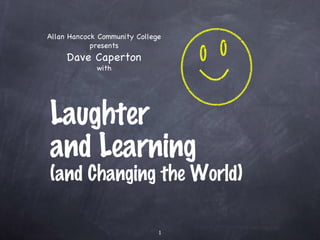Laughter, Learning and Communicating
- 1. Laughter and Learning (and Changing the World) Allan Hancock Community College presents Dave Caperton with
- 2. What¡¯s in it for You? The missing piece of your mission that will energize staff and students. Three things all staff needs (besides a paycheck) that everyone can help provide. The brain¡¯s learning switch and how you can activate it. How to change your world in 5 steps.
- 3. A Learning Philosophy ¡° It is the supreme art of the teacher to awaken joy in creative expression and knowledge.¡± -Albert Einstein
- 4. ¡° Positive IONs¡± MISS- ION Your unifying purpose PASS- ION The fuel that drives the efforts COMPASS- ION How you get others to go with you COMMUNICAT -ION How you share the experience
- 5. Understanding what people really want? High pay Job Security Opportunity for promotion U.S. Department of Labor survey Employers said:
- 6. Understanding what people really want? Recognition for the job they¡¯ve done (Sincere Gratitude) To be treated as a valuable part of the organization That someone CARES about them U.S. Department of Labor survey Employees said:
- 7. Your Mission SERVICE - Who you serve SUCCESS - How it is defined JOY - How do you create it?
- 8. STRESS! ¡° The body¡¯s response to any demand placed upon it.¡± -Dr. Hans Selye ( The Stress of Life )
- 9. Learning is primarily an emotional experience Memory formation occurs in the emotional centers of the brain
- 10. The BIG QUESTION WHAT identifies the objective HOW is procedure WHY is where change happens
- 11. E + MOTION The only place where ¡° DOING ¡± comes before ¡° FEELING ¡± is in the dictionary.
- 12. From 12 Mind-Brain Principles (Caine and Caine, 1991) 1. The brain is a complex adaptive system. 2. The brain is a social brain. 3. The search for meaning is innate. 4. This search occurs through patterning. 5. Emotions are critical to patterning. 6. Every brain simultaneously perceives and creates parts and wholes. 7. The brain processes directly and peripherally. 11. Learning is enhanced by challenge and inhibited by threat.
- 13. The HUMOR RESPONSE Smile Laughter Violent Laughter PEE!
- 14. Face-to-Face Communication WORDS = 7% VOICE = 38% PHYSICAL = 55%
- 15. The Duchenne Smile Has real perceived emotional value Involves the muscles around the eyes Stimulates a neurochemical response consistent with joy
- 16. PESSIMISM ¡° The difference between optimism and pessimism lies in how we explain adversity to ourselves.¡± -Martin Seligman (Univ. of Pittsburgh)
- 17. ADVERSITY ¡° Adversity is like a strong wind that tears us away from all but the things that cannot be torn, so that we see ourselves as we really are.¡± - Arthur Golden
- 18. The 3 Ps of Pessimism PERSONAL - It¡¯s all about ME! PERVASIVE - It¡¯s not one thing, it¡¯s everything PERMANENT - Rats-in-a-cage
- 19. OPTIMISTS see adversity as: RANDOM - It¡¯s not my luck, it¡¯s just my turn LIMITED - Something is wrong, but not everything TEMPORARY - This too shall pass
- 20. The A,B,C,D,Es of MOTIVATION A is for ADVERSITY B is for BELIEF C is for CONSEQUENCES D is for DISPUTE E is for ENERGIZE
- 21. Your Mission Revisited SERVICE - Leading by serving emotional needs. SUCCESS - Realize the potential of an emotionally nourished team. JOY - ¡° awaken joy in creative expression and knowledge.¡±
- 22. Changing the Filters and Improving the Flow of Communication Allan Hancock Community College presents Dave Caperton with
- 24. O.P.E.N. Communication O ther P eople¡¯s E motional N eeds
- 25. Mutual R-E-S-P-E-C-T (this is what it means to me) Seeks understanding Honest Acknowledges other¡¯s point of view Listens actively Focuses on issues Consistent with actions
- 26. How clean are your FILTERS ? Emotions Attitudes Grudges Groups you belong to What you take in
- 27. Can make negative attitudes intractable Negative if shared cynicism is a prerequisite for membership Can be a forum for discontent Creates powerful situational forces that shape human behavior Groups and the Desire to Belong
- 28. Elimination is the Key What we take in determines what we get out when we¡¯re under pressure. What do we read, watch and listen to? What thoughts do we entertain? What words do we speak? What company do we choose?
- 29. The Power of Focus JOY PAIN
- 30. 3 Keys to Robust Living A Sense of Humor - compassionate humor reduces stress, boosts immunity Unconditional Love - Servant¡¯s attitude Community - Connections are crucial
- 31. L.A.F . Soft issues at the heart of hard problems Love - Unconditionally Accept - What (and who) you cannot change Forgive - Whether they deserve it or not
- 32. Compassionate Humor: Is a COPING STRATEGY Provides a PERCEPTION OF CONTROL Is associated with JOY CONNECTS PEOPLE like almost nothing else
- 33. A HUMOR Inventory How does AHCC make work enjoyable? How do YOU make work enjoyable? Share a humorous experience from your life (work, family, etc.) What is one challenge or adversity that you could better handle with a sense of humor?
- 34. The Primary and Secondary Directives First: Do what is right Second: Do what works If doing what works contradicts doing what is right, no good long-term effect can be accomplished.
- 35. www.happinessisafunnything.com Identify and remove obstacles to joy Successfully use humor to build rapport (even if you aren¡¯t funny). Learn two choices that will unlock happiness in the NOW! Be more valuable to others.



































